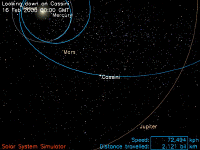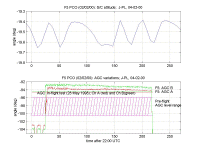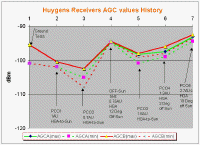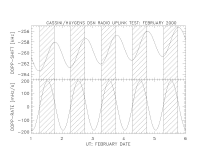Huygens fifth checkout detailed report
 4 February 2000
4 February 2000
The preliminary analysis of the data of the fifth checkout which was executed during the night of Feb. 2 has been successfully completed. The Probe was switched on at 22:00 UTC on 2 Feb. and switched off at 01.38 UTC on 3 Feb.in direct visibility with NASA's DSN station in Goldstone, California. The Huygens checkout telemetry data were transmitted to NASA's DSN Goldstone station in real time through the Cassini Orbiter X-band downlink. Once they had arrived at JPL's Cassini Control Centre, then were transmitted directly to HPOC in ESOC, Darmstadt (D). Of course they arrived about 25 minutes later on Earth, as this is the time it takes for radio wave to propagate from Cassini/Huygens to Earth which were separated by about 440 000 000 km at the time of the checkout. A preliminary analysis of the system-level telemetry data was performed by the Flight Operations Team at the Huygens Probe Control Centre at ESOC, Darmstadt, (D) with the support of the Huygens Prime industrial contractor, Alcatel, Cannes (F). The analysis of the payload data has also been performed by the six instrument teams. It all confirms that the checkout was very nominal and the Probe and its payload are in excellent health.
Figure 1. Time of checkout
Further details about the results of the checkout
Figure 2. Antenna boresight
To recall, that the checkout was performed with the Orbiter's High Gain Antenna (HGA) pointed to Earth. The Sun was about 19.5° away from the antenna boresight. For the first time, the HGA, which is permanently connected to the input of the Huygens receivers, was looking at the cold deep sky during a checkout out. This makes a big difference in terms of radio noise injected into the Huygens receivers. The deep sky system temperature is about 27 K compared to the > 1200 K system temperature when looking at the Sun. The deep sky conditions are much closer to those we expect during the Probe mission when the HGA will be pointed at Titan as we predict a system temperature of about 113 K when looking at Titan. This all sounds rather detailed but that's a very important parameter for the calibration of the effects of the radio noise during the operation of the Probe relay.
The variation of the AGC levels obtained during the checkout are shown in the bottom panel of Fig 3.
Figure 3
For reference to the similar plots produced for the previous checkout we show the orbiter attitude profile (at around 19.5°away from the Sun) during the checkout. The AGC level varied between about -92 and -94 dBm which is the best value ever obtained. An history of the AGC measurements during all checkouts, the special Off-Sun test carried out after the 2nd checkout and the reference ground test measurements is shown in Fig. 4. We shall update this figure after each checkout activity.
Figure 4
The AGC levels reported above are obtained with a fixed signal level transmitted through the umbilical cord that links the Probe and the Orbiter (cruise mode configuration). The AGC is in fact a measure of the Signal-to-Noise ratio. The prime purpose of the Probe S-band Relay calibration tests planned during the two nights following the checkout is to calibrate the AGC level for the range of signal levels expected during the Probe mission. The main factor which will make the signal level received by Cassini's HGA to vary during the Probe descent is due to the fact the the distance between the Orbiter will vary from about 75 000 km at the beginning of the descent to about 20 000 km at the end of the descent. This represents almost a factor of 4 in distance, therefore a factor of 16 in signal strength as it varies as the square of the distance. There are other factors that we take into account to estimate the expected radio signal strength variation during the Probe descent but the number above give a good idea of the expected variation range.
The Probe S-Band Relay Test sequence
The Probe S-band relay test sequence was designed to allow a complete (end-to-end) verification of the performances of the Huygens receivers and to perform a calibration of the AGC signal variation as a function of the received signal strength.
A rather complex sequence was prepared that covered various configurations, both on board the Huygens Probe Support Equipment and at the DSN station in Goldstone (California). The same sequence was planned for both tests on two subsequent nights as it was unlikely that such a complex test sequence would run smoothly at the first try.
The first test was started on 3 Feb. at 18:45 UTC. The test was supported by the Huygens Flight Operations Team and the Huygens industrial prime contractor, Alcatel, Cannes (F) at ESOC. An ESOC radio engineer at the DSN station in Goldstone, supported by members of the Cassini Spacecraft Office at JPL was leading the ground test sequence execution with the help of the DSN station operations team. The Huygens telemtery data were available at both the HPOC in ESOC and at the Orbiter Radio Science Team Operation Centre in JPL, where the Huygens Doppler Wind Experiment (DWE) Principal Investigator was located.
Principle of the S-Band test
The principle of the test is to send from the Goldstone DSN station a radio signal at either of the two S-band frequencies of the Huygens relay link (nominally 2040 and 2098 MegaHertz) frequently of the transmitted had to be adjusted such that the frequency of the received signal would match the one that will be received by the Orbiter's HGA during the Probe mission. As everything moves with respect to each other ( the spacecraft, Titan, the Earth) there are lots of Doppler shifts involved.
During the Probe mission, the relative distance between the Probe and the Orbiter will be decreasing at the rate of 5.65 km/s (the Orbiter velocity with respect to Titan). This will induce a positive (received frequency increase) Doppler shift of about 38 kHz on the 2 gigahertz signal.
During the S-band tests, the Cassini/Huygens spacecraft moves away from the Earth at about 40 km/s and the Earth rotation induces an additional differential velocity between the spacecraft and the ground station. (see Fig. 5).
Figure 5
It all amounts to an average negative ( received frequency decrease) of about 260 kilohertz on chain A at 2040 Megahertz and 268 kilohertz on chain B at 2098 megahertz. During the whole duration of the test, the Doppler shift varies by about ± 2 kilohertz. It all sounds a bit complicated but that is only simple arithmetics. For making sure we got it right, it required a few independent evaluations of the estimated Doppler shift, so as to make sure that Huygens would see the radio signals at the right frequencies. It was indeed cross-checked by a few of the people involved in the test and it worked! During the first night, we heard back from Huygens that it had received the correct signals on both chains. This was the good news.
Test Status Report
We however encountered a few glitches both in the configuration of the Huygens receivers and in the test set-up at Goldstone. The onboard configuration problem was easy to identify. The Chain A can be driven either by the standard Temperature Controlled Oscillator (TCXO) or by the DWE Ultra Stable Oscilator (USO). The sequence configuration was not initialised properly at the start of the test as it started with the DWE/USO to drive the chain while it should have been set to use the TCXO. It was not possible to correct this with an immediate real time telecommand. The sequence returned to the expected configuration when it reached the point where a pre-programmed telecommand was issued to select Power On and select the USO. From that point on, the sequence executed nominally.
A special telecommand was prepared by the Huygens Flight Operations Team and transmitted to JPL for uplink to the spacecraft on the subsequent DSN pass (DSN station in Madrid, Spain) so as to configure properly the sequence at the start of the test for the 2nd night.
The receivers locked nominally when an unmodulated carrier was transmitted on both chains. This part of the test was successfully completed during the 1st night. This was the other good news. However the receivers locked only irregularly when the data modulation was imposed on the carrier. The reason for this is under investigation. It's most likely that it's due to a set-up problem in the test equipment used to modulate the carrier with a simulated Huygens data frame. This is the bad news.
Hopefully the problem will be understood and a solution will be found before the scheduled start of the activities today , 4 Feb. at 21:45 UTC. Bear with us as it's a challenging test. We will report on the results after the week-end. Stay tuned!.
Report by J-P. Lebreton
Huygens Project Scientist
HPOC, ESOC





